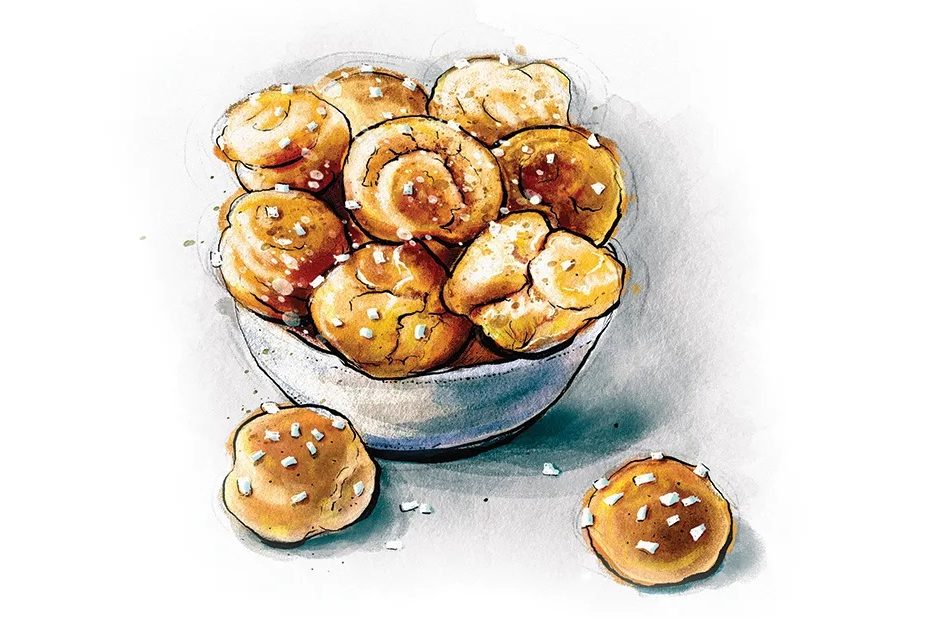I have become obsessed with the French idea of goûter, the time in the afternoon when French schoolchildren have a sweet treat to tide them over from the end of the school day until dinner. It’s just teatime, really, a pause for an afternoon snack — my kid has the same, but we don’t have such an elegant word for it (and his tends to be a gobbled Babybel, and rejected cucumber sticks, which is far less fun) — but giving it its own distinct name and place in the day is charming.
Chouquettes are terribly chic, with their neat, easily replicable shape and minimalist sugar decoration
Actually I think I’m just always looking for an excuse for another snack; always happy to introduce extra little codified meal times to my daily life — not just goûter, but Swedish fika (a kind of ritualized coffee break, morning or afternoon), Italian aperitivo hour (to mark the end of the working day), perhaps a German Kaffee und Kuchen (traditionally mid-afternoon). No thank you, though, to brunch which elides two meals into one, rather than introducing an extra snacking hour.
The most beloved goûter for French children is squares of dark chocolate in a piece of buttered baguette, but I think I’d be stretching the limits of recipe writing to give you instructions for that. Also popular, however, are chouquettes.
Chouquettes are small choux puffs, decorated just with pearl sugar — a small, opaque, crunchy nibbled sugar that looks like snowfall. Pearl sugar, also known as decorating sugar, is now relatively available in American supermarkets, sometimes in its Swedish form, parlsocker. The chouquettes are about the size of a golf ball, and designed to be simple mouthfuls, crisp and impossibly light. Even the name is adorable, with the “ette” indicating their small size. It sounds like the name of an animal sidekick in a modern Disney film (perhaps an owl?).
Choux is a pastry made by cooking together flour, butter and water or milk, and then adding eggs until it reaches dropping consistency. It is piped into various different shapes, and then cooked in the oven, where it will puff into rounded shells, and then dry out, so that the outside is crisp, and the inside is hollow. “Choux” means cabbage, as this is what the cooked pastry balls resemble with their slightly craggy exterior. Depending on your plan, they are then piped full of cream, custard or praline, and often decorated elaborately on the outside.
But chouquettes are choux at its simplest: no need for fillings like profiterole or tricky piping as with a Paris-brest. Even so, choux can be intimidating because it’s hard to prescribe the number of eggs needed to achieve the correct texture: it depends not only on the size of your eggs, but also how much liquid has been cooked out of the mixture before they are added. Go slowly, add the eggs in small increments: you can always add more, but you can’t take away. Choux is ready when, if you lift a load of it onto your spatula and shake it off, you are left with a deep, distinctly formed “V” of batter hanging down from the spatula. If it is undefined, add a little bit more egg, and try again.
The single-stage nature of chouquettes naturally makes them a great place to start with choux if you feel unsure, because it’s not a multi-level preparation that requires custards and creams, ganaches and faffing, cooling times and so on. And the size of the choux balls means that the cooking time is brief. Less of an epic, more of a side-quest.
But why should children have all the fun? Chouquettes are terribly chic, with their neat, easily replicable shape, and minimalist sugar decoration. Serve them with coffee after a meal or in place of a mid-morning biscuit. Their size and lightness make them irresistible: they are just small enough to pop into the mouth in one bite… and then another, and another. And being unfilled means they can sit on the counter in an airtight container, no need to be refrigerated, no cream filling bringing sogginess. That’s if their siren call means they aren’t eaten before they’ve even cooled down.
Makes 30
Takes 20 minutes
Cooks 25 minutes
- ¼ cup butter
- ½ tsp salt
- 1 tbsp superfine sugar
- ½ cup whole milk
- ½ cup plain flour
- 3 eggs, beaten
- Pearl sugar, to decorate
- Preheat the oven to 350°F and line a large baking tray with baking paper. Heat the butter, salt, sugar and milk in a large saucepan over a medium-high heat until the milk begins to boil. Add the flour and stir rapidly into the liquid until a dough forms. Cook the dough, stirring, until it comes easily away from the sides of the pan and you can hear it gently sizzle. Turn the dough onto a large plate, and leave to cool for ten minutes
- Once warm rather than hot, place the mixture into a bowl and add the beaten eggs in small increments, beating each addition thoroughly — you will probably not need all the eggs, so go slowly. To test the choux’s readiness, pick up a large dollop on your spatula and shake it briskly back into the bowl. When the choux has enough egg, the shaken mixture will form a deep, defined “V” that hangs from the spatula. If it doesn’t, add a little more egg, and test again
- Spoon the choux into a piping bag with a medium-sized round piping nozzle, and pipe small blobs onto the lined baking tray. Wet a finger with water and dab down any peaks or tails on the blobs. Generously sprinkle the pearl sugar over the top of them
- Bake for twenty minutes, then open the oven to release any built-up steam and bake for a final five minutes. The choux is ready when it releases from the lined baking tray and moves around easily. You can then turn the oven off and leave the buns in it with the door open to cool; or remove them from the oven and pierce the base of each bun with a slim skewer to release any steam, then set aside on a cooling rack. Enjoy on the day of baking — but if there are any left over, you can refresh them by recrisping them in a hot oven for a few minutes
This article was originally published in The Spectator’s UK magazine. Subscribe to the World edition here.


















